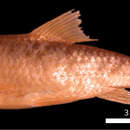Description
provided by Zookeys
The body is comparatively high-backed and laterally compressed in mid-sized specimens but low-backed and almost cylindrical in large specimens. In large specimens a pronounced nuchal hump is present, in smaller specimens it is only weakly developed or absent. The maximum body depth is at the origin of the dorsal fin. The head is short and blunt with a convex ventral profile and a slightly convex to straight dorsal profile (Figs 10, 11). The mouth is terminal or slightly sub-terminal with two pairs of short barbels (Table 2).The body depth is usually greater than the head length (Fig. 12).The eyes are slightly protuberant and lie at the end of the anterior half of the head. The morphometric characters are summarised in Table 1.
The dorsal fin usually has four unbranched and nine to 11 branched rays (Table 3). The last unbranched ray is ossified but not very thick and flexible in its distal part. It is usually shorter than the head (Fig. 4). The anal fin usually has three unbranched and five or six branched rays (Table 4).
There are 31 to 38 scales in the lateral line (Table 5), 4.5 to 6.5 scales above the lateral line (Table 6), four to six scales below the lateral line (Table 7) and 12 to 16 scales around the least circumference of the caudal peduncle (Table 8). The scales are shown in Fig. 5.
The pharyngeal teeth count is 2.3.5-5.3.2 in two specimens, 2.3.5- in 11 specimens, -5.3.2 in two specimens and 1.3.5- in one specimen. The pharyngeal teeth are hooked at their tips (Fig. 6).
Small live specimens are silvery; larger specimens are silvery or bronze coloured and sometimes have yellow pectoral and ventral fins (Fig. 11). Small ethanol-preserved specimens are silvery with a somewhat darker back and a salmon pink hue. Juveniles have a dark lateral spot on the caudal peduncle. Ethanol-preserved adults are yellow-brown and the back is only slightly darker than the rest of the body (Fig. 10).
The maximum length observed in the material examined is 385 mm SL.
Carasobarbus chantrei differs from Carasobarbus apoensis, Carasobarbus canis, Carasobarbus exulatus, Carasobarbus luteus and Carasobarbus sublimus in having 31 to 38 scales in the lateral line vs. 27 to 32, 29 to 35, 26 to 32, 25 to 33 and 27 to 29 respectively and modally 14 scales around the least circumference of the caudal peduncle vs. 12. It differs from Carasobarbus kosswigi and Carasobarbus sublimus in having a crescent-shaped lower lip without median lobe vs. a spatulate lower lip with median lobe and from Carasobarbus exulatus, Carasobarbus fritschii and Carasobarbus harterti in modally having 10 branched dorsal-fin rays vs. nine.
- license
- cc-by-3.0
- copyright
- Kai Borkenhagen, Friedhelm Krupp
- bibliographic citation
- Borkenhagen K, Krupp F (2013) Taxonomic revision of the genus Carasobarbus Karaman, 1971 (Actinopterygii, Cyprinidae) ZooKeys 339: 1–53
- author
- Kai Borkenhagen
- author
- Friedhelm Krupp
Distribution
provided by Zookeys
Carasobarbus chantrei occurs in the Orontes river drainage system (Fig. 7). Two juvenile specimens where collected in Nahr Marqīyah, a coastal river in Syria. This species had never before been reported from this location (Krupp 1985a) and it has most likely been introduced by humans. Two potential records from Nahr Quwayq (MNHN A-3861, MGHN 3554) are discussed in Krupp (1985a, c). Locality data for MHNL 3554 are ambiguous (Krupp 1985a). The locality for MNHN A-3861 is given as “Syria, Aleppo” in Krupp (1985a) and considered to be from Nahr Quwayq. The collection database of the MNHN gives “Origine: Syrie, localité: Alep, Milieu: Continent, Bassin hydrologique: Asi, Cours d’eau: Asi” as locality. As these data are contradictory, it is likely that the specimens do not come from the Nahr Quwayq, but from the Orontes (=Asi) and Carasobarbus chantrei does probably not occur in the Nahr Quwayq. A record from the Ceyhan Nehri (Krupp 1985c) is not backed by specimens. Records from the Tigris-Euphrates basin are misidentified Carasobarbus luteus (Krupp 1985a, Krupp and Schneider 1991) and the specimen from Balıklıgöl at Şanlıurfa in Turkey (SMF 12966) is probably mislabelled or was introduced there (Krupp 1985a). It is not included in the map.
- license
- cc-by-3.0
- copyright
- Kai Borkenhagen, Friedhelm Krupp
- bibliographic citation
- Borkenhagen K, Krupp F (2013) Taxonomic revision of the genus Carasobarbus Karaman, 1971 (Actinopterygii, Cyprinidae) ZooKeys 339: 1–53
- author
- Kai Borkenhagen
- author
- Friedhelm Krupp

